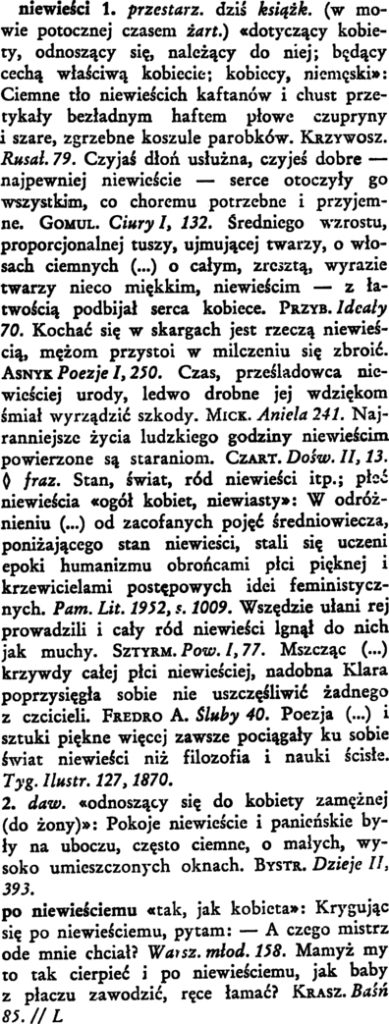Yesterday, I found a word in a Polish birth record from 1814 that I didn’t understand. The entire phrase was “… i okazał nam dziecie płci niewieśący …” and the word in question was “niewieśący”. I had no idea what “niewieśący” meant. The word was not in my Polish/English dictionary, and Google Translate didn’t know what to do with it. Google Translate, did, however, define “niewieści” as “feminine”.
The Słownik języka polskiego (Dictionary of the Polish language) describes the word niewieści in this way:
women 1. outdated. today in books (in colloquial speech sometimes as a joke) «concerning a woman, relating to, belonging to her; being a characteristic of a woman; feminine, unmanly»: the dark background of women’s caftans and shawls was interwoven with haphazard embroidery by flaxen hair and grey, coarse shirts of farmhands. KRZYWOSZ. Rusał. 79. Someone’s helping hand, someone’s good – most probably a woman’s – heart surrounded him with everything that was necessary and pleasant to the sick person. GOMUL. Ciury I, 132. Of medium height, proportionate corpulence, charming face, with dark hair (…) with, by the way, a somewhat soft, feminine expression on his face – he easily won women’s hearts. PRZYB. Idealy 70. To make love in complaints is a womanly thing; it befits husbands to arm themselves in silence. ASNYK Poesje I, 250. Time, the persecutor of female beauty, dared to inflict barely any damage on her charms. MICK. Aniela 241. The most early hours of human life are entrusted to women’s efforts. CZART. Exp. II, 13. <> phrases. State, world, female race etc.; female sex “all women, women”: In distinction (…) from the backward concepts of the Middle Ages, which humiliated the state of women, scholars of the era of humanism became defenders of the fair sex and propagators of progressive feminist ideas. Pam. Lit. 1952, p. 1009. Everywhere the uhlans led the way and the entire female race was drawn to them like flies. SZTYRM. Pow. I, 77. Avenging (…) the wrongs of the entire female sex, the beautiful Clara swore to herself not to make any of her worshippers happy. FREDRO A. Vows 40. Poetry (…) and the fine arts have always attracted the female world more than philosophy and the exact sciences. Weekly Illus. 127, 1870.
2. formerly “referring to a married woman (to a wife)»: Women’s and girls’ rooms were on the sidelines, often dark, with small, high-placed windows. BYSTR. History II, 393.
in a womanly way «like a woman”: Curling in a womanly way, I ask: – And what did the master want from me? Warsz. młod. 158. Are we to suffer like this and in a womanly way, like women wailing with tears, wringing our hands? KRASZ. Fable 85. // L
All of this leads to a very simple translation of “… i okazał nam dziecie płci niewieśący …”; as “… and he showed us a female child …”.
Copyright © 2024 by Stephen J. Danko




